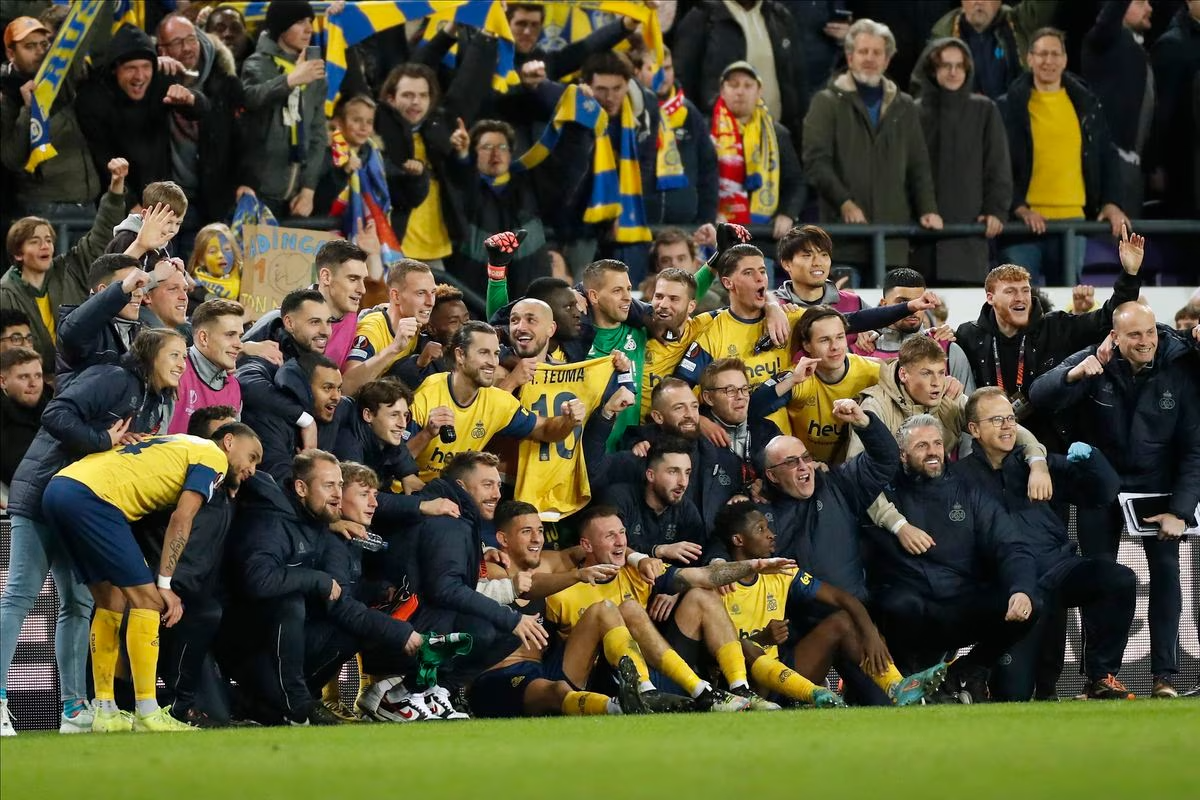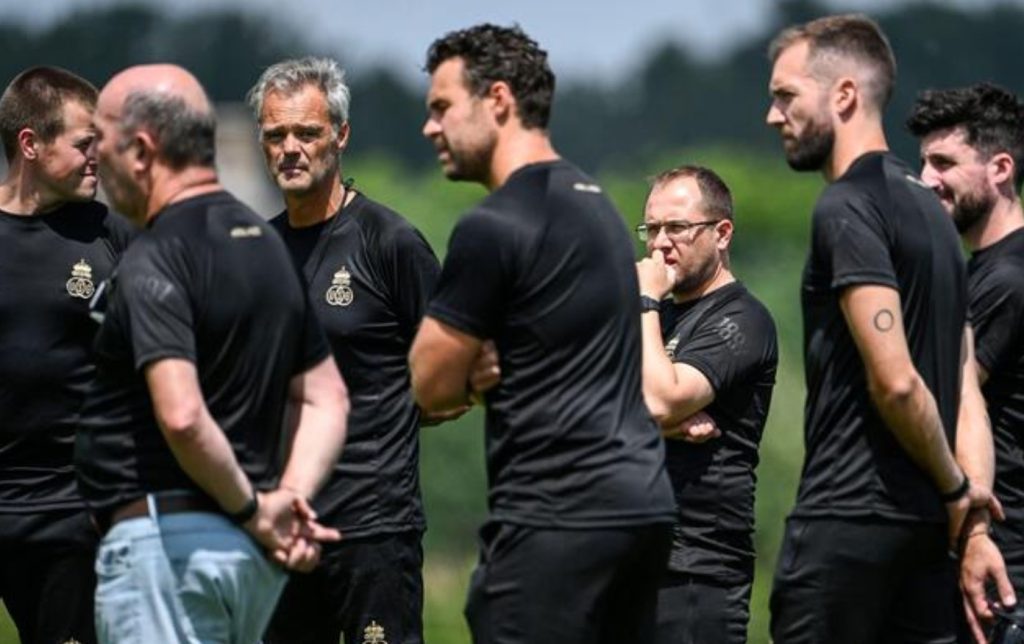
22 May Collaborating with USG: Optimizing Performance and Game Preparation with SportAnalytics
For the first time this year, Union Saint-Gilloise participated in the Europa League, won their group, and reached the quarter-finals with a string of impressive performances. Meanwhile in Belgium, they confirm themselves as one of the top teams in the league and qualify for the playoffs.
We discussed with USG’s Head of Analysis Marc Delcourt about his everyday tasks, how they utilize data to optimize time, and gather insights to enhance game preparation and opposition analysis.
Which are the video analyst’s goals in professional soccer?
“The responsibilities of a video analyst can vary based on the club and coaching staff’s needs. However, the primary role of a video analyst is to be involved in all aspects of team and game preparation. The video analyst plays a significant role in pre-game preparation by observing the next opponent (identifying patterns and tendencies), recording training sessions and games, and aligning them with the team’s philosophy. The ultimate goal is to provide critical insights to the coaching staff and players, both on an individual and collective level, to help in making better decisions in the game.”
The role of video analysis has acquired more and more importance over the last few years. How do you see it could evolve in 5/10 years?
“I believe that in the future the role of video analysis may remain similar but become more specialized through the creation of a dedicated analysis department consisting of multiple analysts rather than one or two. This may allow for a more detailed focus on specific aspects of the game and distribution of tasks among the analysts to cover areas such as set pieces, attacking and defending phases, and individual and collective performance.
This could be similar to the approach taken in American football. As the importance of details increases, having a department with multiple analysts would allow for a more comprehensive and in-depth approach to video analysis.
The role of video analysis has been consistently growing in importance over the past few years, and it is expected that it will continue to evolve incorporating new innovations and technologies.”
Which are the tasks you accomplish to prepare the strategy for the next game? How may these tasks change if you prepare a game in the UEFA competitions?
“As analysts, we do not directly prepare the strategy for the next game. However, we work closely alongside the coach and coaching staff to identify the strengths and weaknesses of the upcoming opponent across various phases of the game. We seek to find opportunities that align with our own team’s philosophy and strengths while making sure to watch out for any potential threats.
Based on contextual criteria, we choose the matches that best suit our requirements.
Then, we watch videos of games played by our upcoming opponents and analyze their playing style and tendencies carefully, checking if the numbers confirm our feelings. Finally we create a comprehensive video report that we share with the coaching staff to support them in preparing their strategy.
When preparing for UEFA competitions, we follow the same process. However, it’s more challenging because we are often unfamiliar with the upcoming teams as they are from foreign leagues. Despite this, we endeavor to assimilate as much data as possible to enable the coaching staff to make more informed decisions.”

Which are the main benefits of SportAnalytics platform?
“Playing every 3 days, particularly during European matches, poses a significant challenge as we need to quickly familiarize ourselves with the next opponent and their playing style. Despite having access to vast amounts of information and data from various providers and websites, sorting and filtering everything for efficient use is a time-consuming and difficult task. The Sportanalytics Platform is a fantastic tool that assists us in becoming more efficient, allowing us to concentrate on pure soccer analysis. Additionally, the platform aids in game analysis by providing various metrics, statistics linked to videos, and charts. This helps us to gain a clear understanding of our next opponent’s playing style, strengths, and weaknesses, benefiting our day-to-day efforts in domestic championships as well as the analysis of our next European opponents by examining their performance in European competitions and their domestic leagues.”
What internal / external decisions have been influenced by using SportAnalytics platform? How do you get value from the data?
“We primarily utilize the platform for scouting our opponents, but the insights provided by the platform combined with our own observations can significantly aid our strategic decision-making. For instance, while preparing for an away game in the Europa League, we crafted a strategy that guided our opponent towards their weaker areas, based on metrics highlighting their playstyle and vulnerabilities, while utilizing our own strengths and abilities.
More broadly, we use the platform to identify and confirm our next opponent’s playing style in various phases of the game, leveraging trends to inform coaching staff and players. It serves as an excellent tool for directing our research and validating our ideas through metrics linked to videos.
Additionally, we employ the platform to assess our performance on both single-game and seasonal trends, from both collective and individual perspectives, by using our customized metrics acting as key performance indicators (KPIs) in accordance with our own philosophy.”
How tracking data improve your analysis?
“Tracking data is an essential feature that greatly improves our daily tasks. However, it requires technical skills and expertise to be used effectively. As we don’t have a dedicated data department or staff, we’ve chosen to partner as SportAnalytics to help and enhance our work in this specific area. This collaboration enables us to leverage tracking data from all our championship games by generating a range of beneficial metrics and statistics.
One practical and impactful example of the insights offered by the platform is its shape analysis and automatic detection of changes in a team’s shape during a game. In modern football (soccer), simply identifying a team’s formation is no longer sufficient, as each team exhibits a distinct playing style both on and off the ball. By examining the average positions of players and every significant change in position, in both of these phases, the platform simplifies the process of understanding a team’s core playing approach. This approach allows us to analyze players based on their specific functions rather than their roles within a specific team’s formation.
Thanks to the tracking data and the platform’s capabilities, we can analyze a broader range of matches more efficiently and thoroughly, allowing us to better prepare. I highly recommend and encourage you to experience a demo to truly appreciate how helpful, useful, and powerful this platform is.”
